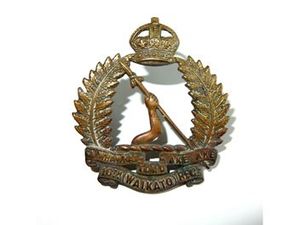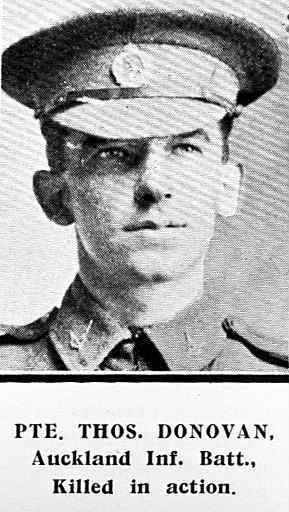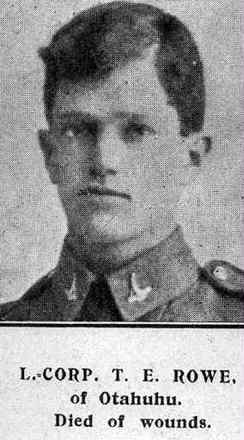16th (Waikato) Regimental Band
The Hamilton Town Band became a military band in late-1912, as an adjunct to the 16th (Waikato) Regiment. The Regiment helped with funding throughout their association, including a salary for a bandmaster and uniforms immediately following the merger.
In 1914, the band acquired a set of silver instruments due to a grant from the Regiment, rather than the brass instruments they would have bought otherwise. These were first displayed for the public in the window at A. Eady and Co., before being presented to the band by the mayor. In May that year they received their colours in a ceremony at Hautapu, a silken banner bearing the motto of the 16th (Waikato) Regiment, "Ka whawhai tonu ake ake". This is a quote from a speech by Rewi Maniapoto, who fought British forces at Orakau in the Waikato in 1864; when invited to surrender, he replied that he and his people would ‘fight for ever and ever’. In September 1914, the band headed the funeral procession for the victims of the Huntly Ralph Mine Disaster. That year they also played at the Ngaruawahia Regatta.
A large number of bandsmen went to fight in WWI. In February 1916, a call was made for instrumentalists to join the Regiment Band, as 21 members had by this time volunteered for the war, and with so many having gone to the front it was becoming increasingly difficult to supply a band at required functions. Only five members remained from the original band. In July 1916, discord was reported to have arisen between the bandmaster, Arthur Salter, and many members of the band, with 13 instrumentalists resigning. Only ten remained in the band. It was suggested that the members had lost confidence in Salter. The alleged "ringleader in the disaffection", Charles E. Scott, joined the Frankton Municipal Band, along with many of the others who had resigned. Scott was transferred from the Hamilton Post Office to Auckland, on the advice of the Regiment to the Postmaster, apparently in retribution. Questions were immediately raised regarding the ownership of the instruments. For a time, official ceremonies were undertaken by the remnants of the Regiment band, combined with members of the Te Awamutu Regimental Band. In late 1916, the band began to play at the newly constructed Band Rotunda.
By 1917, 23 band members had voluntarily enlisted, while the band was said to have one of the finest sets of instruments in New Zealand. In August, fallout from the earlier dispute continued, with the Borough Council declaring the Frankton Municipal Band as the official Hamilton Municipal Band (a name which was then taken on), and not the Regimental Band. Court cases began, with those who had left claiming they had resigned from the Regimental Band, but not from the Hamilton Town Band, and that their instruments therefore belonged to the older Hamilton Town Band, and not to the Regiment. In early 1918, Colonel R.W Cumming of the 16th (Waikato) Regiment stated in a letter to the Hamilton Borough Council that the only way to resolve the issue would be to sever ties with the Hamilton Town Band, and move the Regiment Band to Te Awamutu or Cambridge; this did not eventuate. He saw any potential merger between the new Hamilton Municipal Band and the Regimental Band as impossible.
By August 1917, Bandmaster Salter had been replaced by Bandmaster W.J. Siddall, previously of the Dominion Band, Invercargill. By June 1918, 26 bandsmen in total had been sent to the front. At the end of 1918 it was felt that, with the armistice, it was time for the Town and Regimental bands to "bury the hatchet". Bandmaster Siddall returned to Invercargill in December 1919. In 1920, the band played at the Frankton Railway Station, to welcome Prince Edward (the Prince of Wales) to Hamilton on a Royal Visit.
Any reconciliation of 1918 was seemingly short-lived, with a Supreme Court Case being brought by the Hamilton Municipal Band in mid-1920, seeking return of the instruments, common seal, minute books and other documents of the Hamilton Town Band, held by the Regimental Band since its formation. The decision, however, was in favour of the Regimental Band. Full reconciliation did not occur until 1928 when, due to financial difficulties and lack of public support, the two bands merged to form the Waikato Regimental and Hamilton Municipal Band, under Bandmaster M.K. Mara.
Members
- A. Salter - Bandmaster, 1912-1917
- W.J. Siddall - Bandmaster, 1917-1919
- Percy W. Williams - Bandmaster, 1921
- William (Billy) Allen - Flugel Horn, 1914: Bugler, wounded 1915
- F. Clark - served
- Sergeant Samuel Clothier, 1916 - served
- J. Cook - E Flat Bass, 1914
- S. Cummings - served
- A. Donn - served
- Private Thomas Donovan - First Cornet: killed in action, 5 May 1915, at Dardanelles (Gallipoli)
- A. Downes - served
- S. Ennis - served
- J. Flynn - served
- W. Guest - served; listed as missing in action, 1918
- Private Alfred G. Harvey - 1912, wounded 25 April, 1915
- Lance-Corporal Arthur R. Haybittle - Tenor Horn/E Flat Horn, 1912-1914: Senior Corporal, wounded at Dardanelles (Gallipoli), 1915; killed in action 13 August 1915, Gallipoli
- Hodgkinson - 1914
- Cecil Jamieson - 1914-1916
- Percy T. Jarrett, rifleman - served
- Private L.H. McKenzie - First Trombone: wounded September 1915
- W. McMillan - served
- W. Meyers - served
- T.F. Owrens - tenor horn, E Flat Horn, 1914
- Norman J. Partridge - Flugel: served
- Pass - served
- A.E. Price - Drums, 1914
- Pryor - served
- Private Herbert Victor Reading - First Baritone Horn: killed in action, 25 April 1915, at Dardanelles (Gallipoli)
- C.H. Robertson
- Lance-Corporal Thomas E. Rowe - E Flat horn: wounded 1915, Gallipoli; killed in action 4 October 1917, Belgium
- Henry Salmon - cornet, 1914-1916
- F. Sawyer - served
- Charles E. Scott
- Vincent Sittauer - 1913-1916
- George L. Stroud, rifleman - Second Baritone: served
- John Taylor - euphonium, 1914-1918
- H Thornton - served
- Private Charles Tuatara - served
- H. Vars
- James Wheeler - 1912-1916
Published Articles
- Patriotic Bandsmen; Waikato Regimental Ranks Depleted; Appeal for Instrumentalists, Waikato Times, 5 February 1916, p4
- Discordant Musicians; Regimental Band Dispute; Thirteen Members Resign, Waikato Times, 22 July 1916, p4
- Hamilton Municipal Band, Waikato Times, 19 June 1918, p6
- A Reconciliation Between the Hamilton Bands, Waikato Times, 21 December 1918, p7
- Hamilton Town Band: Question of Identity, Auckland Star, 23 June 1920, p6
- Town Bands Property: Suit for Recovery Fails, New Zealand Herald, 5 July 1920, p4
- Two Bands Amalgamate: Decision at Hamilton; Lack of Public Support. New Zealand Herald, 11 February 1928, p10



